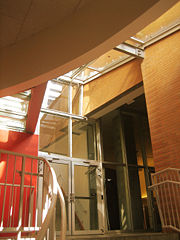
Science Commons
Encyclopedia

Creative Commons
Creative Commons is a non-profit organization headquartered in Mountain View, California, United States devoted to expanding the range of creative works available for others to build upon legally and to share. The organization has released several copyright-licenses known as Creative Commons...
project for designing strategies and tools for faster, more efficient web-enabled scientific research. The organization identifies unnecessary barriers to research, crafts policy guidelines and legal agreements to lower those barriers, and develops technology to make research data and materials easier to find and use. Its goal is to speed the translation of data into discovery and thereby the value of research.
Science Commons is located at the MIT Computer Science and Artificial Intelligence Laboratory
MIT Computer Science and Artificial Intelligence Laboratory
MIT Computer Science and Artificial Intelligence Laboratory is a research laboratory at the Massachusetts Institute of Technology formed by the 2003 merger of the Laboratory for Computer Science and Artificial Intelligence Laboratory...
in the Ray and Maria Stata Center
Stata Center
The Ray and Maria Stata Center or Building 32 is a academic complex designed by Pritzker Prize-winning architect Frank Gehry for the Massachusetts Institute of Technology . The building opened for initial occupancy on March 16, 2004...
at the Massachusetts Institute of Technology
Massachusetts Institute of Technology
The Massachusetts Institute of Technology is a private research university located in Cambridge, Massachusetts. MIT has five schools and one college, containing a total of 32 academic departments, with a strong emphasis on scientific and technological education and research.Founded in 1861 in...
in Cambridge
Cambridge, Massachusetts
Cambridge is a city in Middlesex County, Massachusetts, United States, in the Greater Boston area. It was named in honor of the University of Cambridge in England, an important center of the Puritan theology embraced by the town's founders. Cambridge is home to two of the world's most prominent...
, Massachusetts
Massachusetts
The Commonwealth of Massachusetts is a state in the New England region of the northeastern United States of America. It is bordered by Rhode Island and Connecticut to the south, New York to the west, and Vermont and New Hampshire to the north; at its east lies the Atlantic Ocean. As of the 2010...
.
History
When Creative Commons began, the founding board members expressed an interest in expanding the Creative Commons model to the sciences. Recognizing that developing open pathways for scientific research would be complex and contentious, the Creative Commons board did not feel armed at that point with the expertise or the technical capability to enter into that territory.
Biological Materials Transfer Project
The Biological Materials Transfer Project (MTA) develops and deploys standard, modular contracts to lower the costs of transferring biological materials such as DNA, cell lines, model animals and more. The MTA project covers transfer between non-profit institutions, as well as offering transaction solutions to transfers between non-profit entities and for-profit institutions. It integrates existing standard agreements and new Science Commons contracts into a Web-deployed suite, allowing for the emergence of a transaction system along the lines of Amazon or eBay by using the licensing as a discovery mechanism for materials.This metadata driven approach is based on the success of the Creative Commons licensing integration into search engines, further allowing for and facilitating the integration of materials licensing into the research literature itself and databases. The hope being that scientists would eventually be only one click away from accessing and/or ordering the materials referenced in the scholarly literature as they perform their research.
Neurocommons
Science Commons’ Neurocommons project sets out to create an Open Source knowledge management platform for biological research. The platform combines open access materials (making up the knowledgebase) and open source software (in the form of an analytic platform). The software is still under development, but builds off our existing progress in creating a knowledgebase of relationships by applying text mining and natural language processing to open biomedical abstracts. These two elements together represent a viable open source platform based on open content and open Web standards.Science Commons is launching this effort in neuroscience, indicative by the name of the project, in order to create network effects within a single therapeutic area and to leverage the connections developed with neurodegenerative disease funders through their MTA work. The long-term elements of the Neurocommons revolve around the mixture of commons-based peer editing and annotation of the pilot knowledge project, as well as in the creation of an open source software community around the analytics platform.
The Neurocommons project comes out of Creative Commons’ history with the Semantic Web. John Wilbanks
John Wilbanks
John Wilbanks is a Senior Fellow at the Ewing Marion Kauffman Foundation and runs the Consent to Research Project.-Education and career:John Wilbanks grew up in Knoxville, TN. He attended Tulane University and received a Bachelor of Arts in Philosophy in 1994...
, Executive Director of Science Commons, founded the Semantic Web for Life Sciences project at the World Wide Web Consortium and led a semantics-driven bioinformatics startup company to acquisition in 2003. Science Commons Principal Scientists Jonathan Rees and Alan Ruttenberg play key roles in the Semantic Web development efforts for science.
Scholar's Copyright Project
The Scholar’s Copyright Project lowers the barriers to Open Access (OA) by reducing transaction costs and eliminating contract proliferation. Through the Scholar’s Copyright project, Science Commons offers a spectrum of tools and resources catering to both methods of achieving Open Access. Here is a glimpse of our efforts and successes to date.Open Access Data Protocol
The Science Commons Open Access Data Protocol is a method for ensuring that scientific databases can be legally integrated with one another. The protocol is not a license or legal tool, but instead a methodology and best practices document for creating such legal tools in the future, and marking data in the public domain for machine-assisted discovery.For more information about the Protocol and our stance on Databases, visit our FAQ page, where you can read our new FAQ on the Database Protocol. Also, click here to read the official announcement of the Protocol, issued in concordance with the 5th anniversary of Creative Commons’ licenses.
OA publishing and CC licensing
One road to Open Access is to publish in an OA journal. More than 250 peer-reviewed scholarly journals implement their OA philosophy using Creative Commons licensing. Key adopters include the Public Library of SciencePublic Library of Science
The Public Library of Science is a nonprofit open-access scientific publishing project aimed at creating a library of open access journals and other scientific literature under an open content license...
(PLoS), Hindawi, and BioMed Central
BioMed Central
BioMed Central is a UK-based, for-profit scientific publisher specialising in open access journal publication. BMC, and its sister companies Chemistry Central and PhysMath Central, publish over 200 scientific journals. Most BMC journals are now published only online. BMC describes itself as the...
.
Each uses the Creative Commons Attribution License, which is a legal implementation of the Open Access vision as laid out by the Budapest Open Access Initiative
Budapest Open Access Initiative
The Budapest Open Access Initiative was a conference convened by the Open Society Institute on December 1-2, 2001. This small gathering of individuals is recognised as one of the major historical, and defining, events of the open access movement....
. The result - more information is made freely available for public consumption, and without unintended consequence
Unintended consequence
In the social sciences, unintended consequences are outcomes that are not the outcomes intended by a purposeful action. The concept has long existed but was named and popularised in the 20th century by American sociologist Robert K. Merton...
s of applying at least 70 years’ worth of control to scientific knowledge.
Scholar's Copyright Addendum Engine (SCAE)
Another road to OA is to put an archive copy of the peer-reviewed article on the Web (”self-archiving”) after publication in a peer-reviewed journal. This approach is gaining significant traction as well, with the European Union, US National Institutes of Health, and the Wellcome Trust adopting policy initiatives based on archives.Although most journals support some form of self-archiving, the number of variables in their policies create real confusion among authors. The Science Commons Author Addenda help scholars negotiate the rights they need to use and distribute their work via self-archiving, eliminating confusion and doubt as to when, where, and how authors can make their work available to the world.
The Scholar’s Copyright Addendum Engine (SCAE) is a simple interface for generating a signature-ready Addendum. The SCAE generates the one page document, amending the copyright transfer agreements issued by publishers. This ensures that the author can make their work freely available on the public Internet whether upon publication, pre-publication (in the form of the author’s final manuscript), or after a certain period of time. This FAQ walks you through step-by-step how to do this.
Open Access Law Program
Over 35 law journals have committed to the Open Access Law program since launch.The Open Access Law (OAL) Program provides a comprehensive set of resources promoting open access in legal scholarship. The program relies on self-assessment and self-reporting, arming the editorial boards of law journals with the means to go OA.
The OAL program consists of a set of principles of OA, committing both author and journal to basic tenets of OA, and a free model agreement between authors and journals that implements the principles in contract.
Visit this site to see what journals are already on board.
Reason behind this focus
Science Commons was launched around the initial relationship with the Public Library of Science, which uses the Creative Commons Attribution license to achieve the OA definition of literature that is free, digital, free of charge, and free of most copyright restrictions. After both convening meetings and engaging in other conversations with various parties invested in scholarly publishing, this focus was chosen.The Creative Commons licenses were selected to use for Open Access rather than creating new copyright licenses in an effort to avoid license proliferation. Science Commons’ work in publishing also responds to the needs of journals in the legal field who did not have the resources to design their own OA agreements (OAL program). Science Commons also saw the emergence of multiple contracts aimed at empowering authors with the ability to retain rights to make archival copies of their scholarly works on the Web. The organization in turn built relationships with the designers of the most-utilized author addenda (SPARC, MIT) to unify the regime and lower confusion among potential users (SCAE).
Using data and CC licenses
Science Commons launched on 16 December 2007 the Protocol for Implementing Open Access Data in conjunction with the Public Domain Dedication License and the Open Knowledge FoundationOpen Knowledge Foundation
The Open Knowledge Foundation is a not-for-profit organization that promotes open knowledge, including open content and open data. It was founded 24 May 2004 in Cambridge, UK...
.
The Protocol is of note because, rather than relying on copyright licenses such as the Creative Commons licenses and the GNU GPL, it provides a rationale and methodology for reconstructing the public domain of data.

